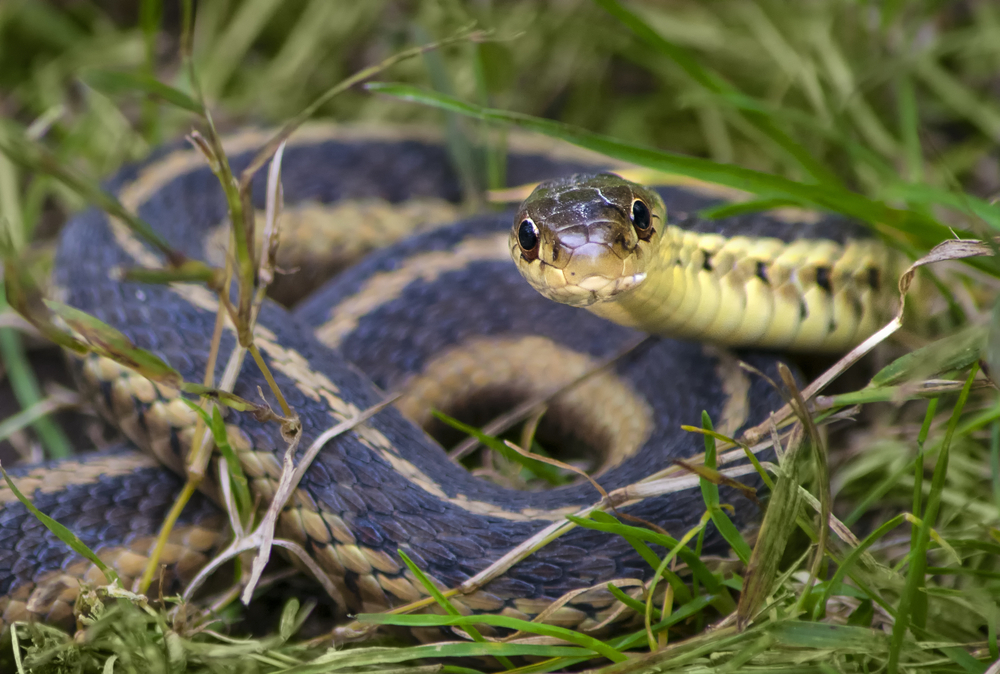Surprising Truths: 10 Interesting Facts About Garter Snakes

Garter snakes are one of the most widespread and recognizable reptiles across North America. Despite their common presence, many misconceptions and unknown facts surround these fascinating creatures.
Often seen slithering through gardens, meadows, and forests, garter snakes exhibit a remarkable adaptability to various environments. Their harmless nature and beneficial role in controlling pest populations make them important to both ecosystems and human communities.
By delving into the surprising truths and interesting facts about garter snakes, we can gain a deeper appreciation for these often-overlooked reptiles and understand the significant role they play in maintaining ecological balance.
1. Widely Distributed Species
Garter snakes boast an impressive geographical range, inhabiting a variety of habitats across North America.
They can be found from the damp, mossy forests of the Pacific Northwest to the arid, sun-baked deserts of the Southwestern United States, and even extending into the wetlands of Canada. This extensive distribution underscores their adaptability to a multitude of environments.
Whether in meadows, marshlands, forests, or suburban gardens, garter snakes seamlessly adjust to their surroundings. Their ability to thrive in both natural and human-altered landscapes highlights their resilience and ecological versatility, making them one of the most successful snake species in North America.
2. Variety of Colors and Patterns
A remarkable aspect of garter snakes is their astonishing variety of colors and patterns, which can vary widely depending on their geographical location. These snakes can display a rich palette of hues, including greens, blues, reds, and browns, often adorned with distinct stripes, blotches, or checkered patterns.
For example, garter snakes in coastal regions may exhibit brighter and more vibrant colors compared to their inland counterparts, who often have more subdued tones to blend into their arid environments.
This regional variation not only showcases the incredible adaptability of garter snakes to different ecosystems but also adds an element of natural beauty to these often-underestimated reptiles.
By examining these differences, we can better understand the evolutionary pressures and environmental factors that influence their exquisite and diverse appearances.
3. Non-Venomous Yet Effective Defenders
Despite common misconceptions, garter snakes are non-venomous and pose no significant threat to humans. Many people mistakenly believe that all snakes are dangerous, but garter snakes break this stereotype with their harmless nature.
Instead of relying on venom to subdue their prey or defend themselves, garter snakes employ a range of defensive behaviors and tactics. When threatened, they may release a foul-smelling musk from their cloacal glands to deter potential predators.
Additionally, they often perform intricate escape maneuvers, such as flattening their bodies to appear larger and more intimidating or quickly slithering away to safety. These strategies enable garter snakes to effectively defend themselves and ensure their survival in a world full of predators.
By debunking the myth of their venomous nature, we can foster a greater appreciation for the fascinating defensive adaptations of garter snakes.
4. Diverse Diet
Garter snakes are remarkable for their varied and opportunistic diet, which plays a crucial role in their adaptability to different environments. These versatile predators consume a wide range of prey, including amphibians like frogs and salamanders, numerous types of insects, and even small mammals such as rodents.
Their hunting techniques are equally diverse; garter snakes are known for their keen sense of smell and ability to track scents with their forked tongues, allowing them to locate hidden prey.
Additionally, they use their quick reflexes and agility to ambush unsuspecting targets, striking with precision before swallowing their meal whole. This dietary flexibility not only supports their survival in diverse habitats but also helps maintain ecological balance by controlling various prey populations.
As a result, garter snakes play an indispensable role in their ecosystems, highlighting their significance beyond their underestimated appearance.
5. Unique Reproductive Methods
Garter snakes exhibit fascinating reproductive methods, primarily through viviparous reproduction, where females give birth to live young rather than laying eggs. This method provides several advantages, especially in regions with unpredictable climates, as it allows the mother to provide a more stable environment for her developing offspring.
After mating, the female garter snake carries the embryos internally, offering protection and warmth throughout the gestation period, which typically lasts two to three months. When ready to give birth, she will deliver a brood ranging from a handful to over fifty live young, depending on the species and environmental conditions.
These newborn snakes are precocial, meaning they are relatively mature and self-sufficient from birth, equipped with the instinctual behavior necessary to hunt and avoid predators.
The growth and development of young garter snakes are rapidly fueled by an opportunistic diet, allowing them to quickly adapt to their environment and contribute to the population stability of this widely dispersed species.
6. Beneficial to Humans
Garter snakes play a crucial role in controlling pest populations, making them highly beneficial to humans. By preying on pests such as insects, slugs, and small rodents, they help to regulate populations that can otherwise become problematic in both agricultural and residential settings.
This natural pest control reduces the need for chemical pesticides, promoting a healthier environment and safeguarding human health. Additionally, garter snakes contribute significantly to the ecological balance within their habitats.
As both predators and prey, they occupy a vital position in the food web, helping to sustain the biodiversity of their ecosystems. Their presence ensures the stability of various ecological processes, underlining their importance beyond their immediate benefits to human activities.
Understanding and appreciating the ecological services provided by garter snakes can foster coexistence and conservation efforts, ensuring that these remarkable reptiles continue to thrive and contribute to the health of our shared environments.
7. Cold Tolerance
Garter snakes demonstrate incredible cold tolerance, showcasing remarkable adaptations that allow them to thrive in cooler climates. One of the key adaptations is their ability to slow down their metabolic processes during temperature drops, thus conserving energy. This physiological change is crucial for survival when food becomes scarce in colder months.
Moreover, garter snakes undergo a process known as brumation, which is akin to hibernation in mammals.
During brumation, these snakes become lethargic and significantly reduce their activity levels. They often seek refuge in communal dens, known as hibernacula, which provide consistent temperatures and protection from extreme cold.
This period of dormancy can last several months, ensuring that they avoid the harshest winter conditions. By understanding these cold tolerance strategies and the brumation process, we gain deeper insights into the resilience and adaptability of garter snakes, underscoring their ability to occupy a wide range of ecological niches.
8. Social Behavior
Garter snakes exhibit intriguing social behavior, particularly through their tendency to live in aggregations and their methods of communication and interaction. Unlike many other snake species that are solitary, garter snakes are often found in groups, especially during hibernation and mating seasons.
This tendency to aggregate in large numbers provides numerous survival benefits, such as increased protection from predators and improved thermoregulation. Communication among garter snakes occurs through a combination of chemical cues and physical interactions.
They utilize pheromones to convey information about their reproductive status, leading to elaborate courtship rituals during the mating season.
Additionally, garter snakes engage in tactile communication, with behaviors such as body rubbing and tongue flicking, which help to establish social bonds and convey essential information within the group. These complex social behaviors highlight the advanced levels of interaction among garter snakes, showcasing their fascinating and often underestimated social lives.
9. Impressive Escape Artists
Garter snakes are impressive escape artists, showcasing an array of abilities and physical adaptations that aid their escape from predators. Their slender, flexible bodies enable swift and agile movements through tight spaces and dense vegetation, providing a quick getaway route when threatened.
Additionally, their cryptic coloration and patterning act as effective camouflage, allowing them to blend seamlessly into their surroundings and evade detection. When confronted by predators, garter snakes can employ a rapid, serpentine motion, confusing attackers and making it difficult for them to pinpoint the snake’s exact location.
Some species also exhibit a defensive mechanism known as “tail luring,” where they twitch their tails to distract predators, potentially allowing the snake to slip away unnoticed.
These traits not only enhance their survival but also underscore the adaptability and ingenuity of garter snakes in evading threats, further illustrating their remarkable role in the animal kingdom.
10. Toxin Resistance
Garter snakes possess remarkable resistance to certain toxins, an adaptation that allows them to prey on creatures that many other predators would avoid due to their chemical defenses. This resistance is particularly notable in their interactions with amphibians, such as the rough-skinned newt, which secretes a potent neurotoxin known as tetrodotoxin (TTX).
While this toxin can be lethal to many predators, garter snakes have evolved a genetic mutation that provides them with immunity, enabling them to consume these otherwise dangerous prey without adverse effects.
Another example of their toxin resistance is their ability to prey on toads, which produce toxic secretions through their skin.
The garter snake’s evolutionary adaptations not only highlight their incredible resilience but also underscore their role as apex predators in controlling populations of chemically-defended prey, maintaining ecological balance in their habitats.
Conclusion
In conclusion, garter snakes reveal a world of astonishing and often overlooked wonders. From their significant role in pest control to their complex social behaviors, these remarkable reptiles demonstrate incredible adaptability and resilience.
Their ability to withstand cold temperatures, evade predators with agility and ingenuity, and resist potent toxins underscores their unique position in the animal kingdom. Garter snakes not only contribute to the ecological balance within their habitats but also offer us a deeper appreciation of the intricate interdependencies that sustain our natural world.
As we reflect on these surprising truths, it becomes clear that garter snakes deserve our respect and admiration. Their presence enriches the ecosystems they inhabit and provides invaluable services that benefit both nature and humanity.
By fostering a greater understanding and appreciation of garter snakes, we can promote conservation efforts and ensure that these incredible creatures continue to thrive. Let us celebrate the intriguing lives of garter snakes and support measures to protect their habitats, recognising the invaluable contributions they make to our planet.




